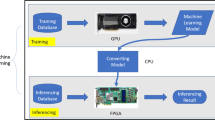Abstract
Target recognition system based on machine learning has the problems of long delay, high power-consuming and high cost, which cause it difficult to be promoted in some small embedded devices. In order to develop a target recognition system based on machine learning that can be utilized in small embedded device, this paper analyzes the commonly used design process of target recognition, the training process of machine learning algorithms, and the working method of FPGA to accelerate the algorithm. In the end, it offers a new solution of target recognition system based on machine learning hardware accelerator. In the solution, the training process of target recognition algorithm based on machine learning is completed in GPU, and then the algorithm is porting to the logic part of SOC in the form of hardware accelerator. The solution be widely used in different needs of the target recognition scenario with the advantage of effectively reduce the system delay, power consumption, size.








Similar content being viewed by others
Explore related subjects
Discover the latest articles and news from researchers in related subjects, suggested using machine learning.References
Choi, W., & Savarese, S. (2014). A unified framework for multi-target tracking and collective activity recognition. Computer Vision ECCV, 7575(1), 215–230.
Zeiler, M. D., & Fergus, R. (2014). Visualizing and understanding convolutional networks. In European conference on computer vision (Vol. 8689, pp.818–833). Cham: Springer.
Fu, L. M. (2014). Machine learning and tubercular drug target recognition. Current Pharmaceutical Design, 20(27), 4307–4318.
Dong, C., Chen, C. L., He, K., & Tang, X. (2014). Learning a deep convolutional network for image super-resolution. In European conference on computer vision (Vol. 8692, pp.184–199). Cham: Springer.
Liu, L., Ma, H., & Lu, M. (2010). A FPGA and zernike moments based near-field laser imaging detector multi-scale real-time target recognition algorithm. In international symposium on information science and engineering (pp.370–374). IEEE Computer Society.
Kleinsmith, A., & Bianchi-Berthouze, N. (2013). Affective body expression perception and recognition: a survey. IEEE Transactions on Affective Computing, 4(1), 15–33.
Donahue, J., Hendricks, L. A., Rohrbach, M., Venugopalan, S., Guadarrama, S., Saenko, K., et al. (2017). Long-term recurrent convolutional networks for visual recognition and description. IEEE Transactions on Pattern Analysis and Machine Intelligence, 39(4), 677.
Kleinsmith, A., & Bianchi-Berthouze, N. (2013). Affective body expression perception and recognition: a survey. IEEE Transactions on Affective Computing, 4(1), 15–33.
Schirner, G., Erdogmus, D., Chowdhury, K., & Padir, T. (2013). The future of human-in-the-loop cyber-physical systems. Computer, 46(1), 36–45.
El-Dahshan, E. S. A., Mohsen, H. M., Revett, K., & Salem, A. B. M. (2014). Computer-aided diagnosis of human brain tumor through mri: A survey and a new algorithm. Expert Systems with Applications, 41(11), 5526–5545.
Anjos, A., Chakka, M. M., & Marcel, S. (2014). Motion-based counter-measures to photo attacks in face recognition. IET Biometrics, 3(3), 147–158.
Dollár, P., Appel, R., Belongie, S., & Perona, P. (2014). Fast feature pyramids for object detection. IEEE Transactions on Pattern Analysis and Machine Intelligence, 36(8), 1532.
Fu, L. M. (2014). Machine learning and tubercular drug target recognition. Current Pharmaceutical Design, 20(27), 4307–4318.
Vink, J. P., & Haan, G. D. (2015). Comparison of machine learning techniques for target detection. Artificial Intelligence Review, 43(1), 125–139.
Zhang, M. L., & Zhou, Z. H. (2014). A review on multi-label learning algorithms. IEEE Transactions on Knowledge and Data Engineering, 26(8), 1819–1837.
Dollár, P., Appel, R., Belongie, S., & Perona, P. (2014). Fast feature pyramids for object detection. IEEE Transactions on Pattern Analysis and Machine Intelligence, 36(8), 1532.
Sprenger, M., Schemm, S., Oechslin, R., & Jenkner, J. (2017). Nowcasting foehn wind events using the adaboost machine learning algorithm. Weather and Forecasting. https://doi.org/10.1175/WAF-D-16-0208.1.
Kazi, M. S. S. (2013). Analyzing intrusion detection using machine learning, adaboost algorithm: An observations study. International Journal of Engineering Trends and Technology, 4(6), 2302–2304.
Gao, L., Cheng, W., Zhang, J., & Wang, J. (2016). Eeg classification for motor imagery and resting state in bci applications using multi-class adaboost extreme learning machine. Review of Scientific Instruments, 87(8), 085110.
Canis, A., Choi, J., Aldham, M., Zhang, V., Kammoona, A., Czajkowski, T., et al. (2013). Legup: An open-source high-level synthesis tool for FPGA-based processor/accelerator systems. ACM Transactions on Embedded Computing Systems, 13(2), 1–27.
Chen, T., Du, Z., Sun, N., Wang, J., Wu, C., Chen, Y., et al. (2014). Diannao: a small-footprint high-throughput accelerator for ubiquitous machine-learning. ACM Sigplan Notices, 49(4), 269–284.
Kadi, M. A., Rudolph, P., Gohringer, D., & Hubner, M. (2014). Dynamic and partial reconfiguration of Zynq 7000 under Linux. In International conference on reconfigurable computing and FPGAS (pp.1–5). IEEE.
Maxim, V., & Zidek, K. (2012). Design of high performance multimedia control system for UAV/UGV based on SOC/FPGA core. Procedia Engineering, 48(1), 402–408.
Viola, P., & Jones, M. (2003). Rapid object detection using a boosted cascade of simple features. In Proceedings of the IEEE computer society conference on the computer vision and pattern recognition, CVPR 2001. (Vol. 1, pp. I-511–I-518). IEEE.
Gentillon, H., Stefańczyk, L., Strzelecki, M., & Respondek-Liberska, M. (2017). Prenatal brain MRI samples for development of automatic segmentation, target-recognition, and machine-learning algorithms to detect anatomical structures. F1000. Research, 6, 93.
Acknowledgements
This paper is acknowledged by the National Natural Science Foundation of China (Grant No. 51502209), the Government Support Enterprise Development Funding of Hubei Province (Grant No. 16441), the Three-dimensional Textiles Engineering Research Center of Hubei Province, the Anqing Technology Transfer Center of Wuhan Textile University.
Author information
Authors and Affiliations
Corresponding author
Additional information
Yu Li, Fengyuan Yu, Qian Cai and Meiyu Qian are co-first authors.
Rights and permissions
About this article
Cite this article
Li, Y., Yu, F., Cai, Q. et al. Design of Target Recognition System Based on Machine Learning Hardware Accelerator. Wireless Pers Commun 102, 1557–1571 (2018). https://doi.org/10.1007/s11277-017-5211-2
Published:
Issue Date:
DOI: https://doi.org/10.1007/s11277-017-5211-2




